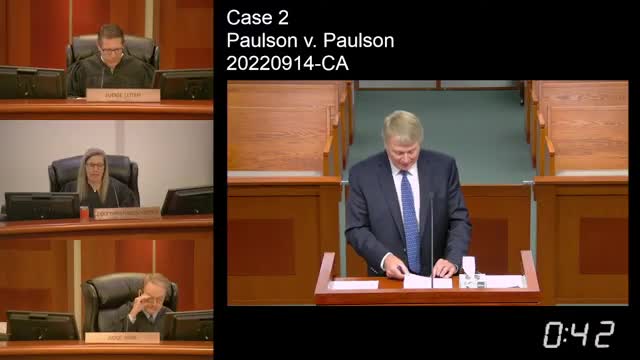Court Reviews Prenuptial Agreement and Tracing Issues in Christopher and Trishna's Property Case
September 25, 2025 | Utah Court of Appeals Live Stream, Utah Appellate Court, Utah Judicial Branch, Utah
This article was created by AI summarizing key points discussed. AI makes mistakes, so for full details and context, please refer to the video of the full meeting. Please report any errors so we can fix them. Report an error »

The Utah Court of Appeals convened on September 25, 2025, to deliberate on the complex case of Paulson v. Paulson, focusing on the division of financial assets and properties amid a contentious divorce. The meeting highlighted the intricacies of the couple's prenuptial agreement and the implications of property ownership during their 30-year marriage.
Central to the discussions were 19 summary judgments that, while not identical, shared factual similarities regarding the management and ownership of various properties. Christopher Paulson was identified as the primary manager of these financial assets, with properties held in both joint and individual names. The prenuptial agreement was scrutinized, with arguments suggesting it did not encompass proceeds from property sales, only addressing present income.
Key points of contention included the interpretation of property acquired during the marriage. The prenup stipulated that property acquired by either party remained separate unless both names were on the title. This led to debates about the nature of community property under California law, which presumes joint ownership when titles are held in both names.
The court also examined the concept of "exhaustion tracing," a method used to determine the nature of funds used for property purchases. It was argued that the trial court misapplied this theory, failing to establish the necessary records to prove whether community property was exhausted at the time of acquisition. The lack of documentation regarding account balances during the marriage complicated the case, as both parties contributed to the commingling of assets.
The discussions raised critical questions about the burden of proof regarding the classification of funds as separate or community property. The court noted that Christopher Paulson did not provide sufficient evidence to demonstrate that the initial funds used for investments were his separate property, leading to a presumption that the assets were Trishna's separate property from the outset.
As the case progresses, the court's decisions will have significant implications for the equitable distribution of assets in divorce proceedings, particularly in cases involving complex financial arrangements and prenuptial agreements. The outcome may set important precedents for future cases in Utah and beyond.
Central to the discussions were 19 summary judgments that, while not identical, shared factual similarities regarding the management and ownership of various properties. Christopher Paulson was identified as the primary manager of these financial assets, with properties held in both joint and individual names. The prenuptial agreement was scrutinized, with arguments suggesting it did not encompass proceeds from property sales, only addressing present income.
Key points of contention included the interpretation of property acquired during the marriage. The prenup stipulated that property acquired by either party remained separate unless both names were on the title. This led to debates about the nature of community property under California law, which presumes joint ownership when titles are held in both names.
The court also examined the concept of "exhaustion tracing," a method used to determine the nature of funds used for property purchases. It was argued that the trial court misapplied this theory, failing to establish the necessary records to prove whether community property was exhausted at the time of acquisition. The lack of documentation regarding account balances during the marriage complicated the case, as both parties contributed to the commingling of assets.
The discussions raised critical questions about the burden of proof regarding the classification of funds as separate or community property. The court noted that Christopher Paulson did not provide sufficient evidence to demonstrate that the initial funds used for investments were his separate property, leading to a presumption that the assets were Trishna's separate property from the outset.
As the case progresses, the court's decisions will have significant implications for the equitable distribution of assets in divorce proceedings, particularly in cases involving complex financial arrangements and prenuptial agreements. The outcome may set important precedents for future cases in Utah and beyond.
View full meeting
This article is based on a recent meeting—watch the full video and explore the complete transcript for deeper insights into the discussion.
View full meeting

